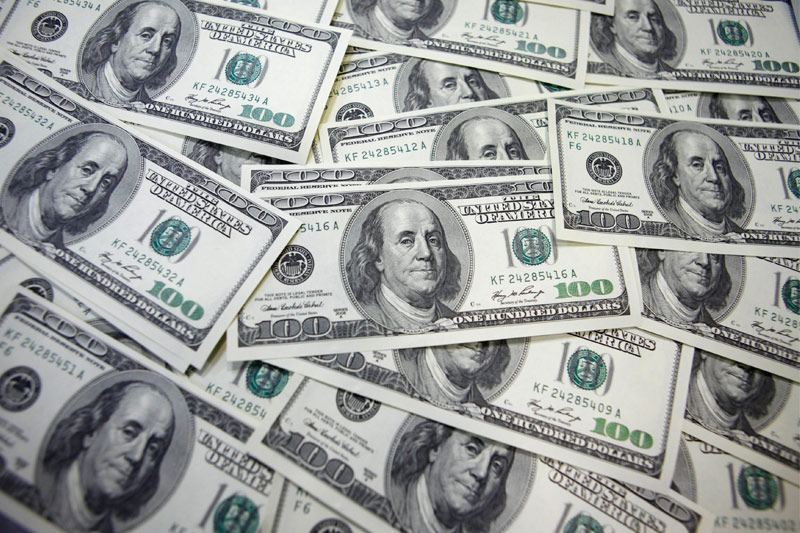Investing.com - The U.S. dollar was mixed against the other major currencies on Wednesday, as market participants awaited the Federal Reserve’s rate decision later in the session.
During U.S. morning trade, the dollar was higher against the euro, with EUR/USD down 0.27% to 1.2950.
The single currency fell to session lows earlier after data showed that the flash euro zone manufacturing purchasing managers’ index fell to 45.3 in October from a final reading of 46.1 in September. Analysts had expected the index to ease up to 46.6 in October.
Germany’s flash manufacturing PMI fell to 45.7 in October, from a final reading of 47.4 in September, adding to concerns over a slowdown the euro zone’s largest economy.
Separately, a report by German research institute Ifo showed that its closely watched business climate index deteriorated to its lowest level since March 2010 this month.
The poor euro zone data was offset by data showing that China's HSBC manufacturing PMI improved to 49.1 in October, compared with a final reading of 47.9 in September.
The greenback was lower against the pound, with GBP/USD up 0.41% to 1.6016.
Demand for sterling was underpinned after Bank of England Governor Mervyn King said Tuesday that policymakers would have to think "long and hard" before implementing further quantitative easing measures.
Elsewhere, the greenback was little changed against the yen, with USD/JPY dipping 0.02% to 79.83 but pushed higher against the Swiss franc, with USD/CHF rising 0.20% to 0.9341.
The greenback was mixed against its Canadian, Australian and New Zealand counterparts, with USD/CAD rising 0.15% to 0.9939, AUD/USD climbing 0.60% to 1.0325 and NZD/USD rising 0.36% to 0.8147.
The Canadian dollar found support earlier in the session after the Bank of Canada’s monetary policy report said it envisages "gradual" interest rate increases over the next two years and added that the biggest domestic risk to the economy comes from record levels of household debt.
The report came after the central bank left rates unchanged at 1.00% on Tuesday.
The dollar index, which tracks the performance of the greenback versus a basket of six other major currencies, was up 0.15% to 80.14.
The dollar was little changed earlier after the Commerce Department said U.S. new home sales rose by 5.7% to a seasonally adjusted 389,000 units in September, beating expectations for a 3.2% increase to 385,000.
Later Wednesday, the Federal Reserve was to announce its benchmark interest rate and release its first monetary policy statement since the central bank announced a third round of quantitative easing in September.
During U.S. morning trade, the dollar was higher against the euro, with EUR/USD down 0.27% to 1.2950.
The single currency fell to session lows earlier after data showed that the flash euro zone manufacturing purchasing managers’ index fell to 45.3 in October from a final reading of 46.1 in September. Analysts had expected the index to ease up to 46.6 in October.
Germany’s flash manufacturing PMI fell to 45.7 in October, from a final reading of 47.4 in September, adding to concerns over a slowdown the euro zone’s largest economy.
Separately, a report by German research institute Ifo showed that its closely watched business climate index deteriorated to its lowest level since March 2010 this month.
The poor euro zone data was offset by data showing that China's HSBC manufacturing PMI improved to 49.1 in October, compared with a final reading of 47.9 in September.
The greenback was lower against the pound, with GBP/USD up 0.41% to 1.6016.
Demand for sterling was underpinned after Bank of England Governor Mervyn King said Tuesday that policymakers would have to think "long and hard" before implementing further quantitative easing measures.
Elsewhere, the greenback was little changed against the yen, with USD/JPY dipping 0.02% to 79.83 but pushed higher against the Swiss franc, with USD/CHF rising 0.20% to 0.9341.
The greenback was mixed against its Canadian, Australian and New Zealand counterparts, with USD/CAD rising 0.15% to 0.9939, AUD/USD climbing 0.60% to 1.0325 and NZD/USD rising 0.36% to 0.8147.
The Canadian dollar found support earlier in the session after the Bank of Canada’s monetary policy report said it envisages "gradual" interest rate increases over the next two years and added that the biggest domestic risk to the economy comes from record levels of household debt.
The report came after the central bank left rates unchanged at 1.00% on Tuesday.
The dollar index, which tracks the performance of the greenback versus a basket of six other major currencies, was up 0.15% to 80.14.
The dollar was little changed earlier after the Commerce Department said U.S. new home sales rose by 5.7% to a seasonally adjusted 389,000 units in September, beating expectations for a 3.2% increase to 385,000.
Later Wednesday, the Federal Reserve was to announce its benchmark interest rate and release its first monetary policy statement since the central bank announced a third round of quantitative easing in September.
